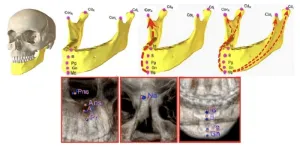(Press-News.org) Millions of people around the world undergo some type of orthodontic treatment each year due largely to developmental deformities in the jaw, skull, or face. Computed tomography (CT) imaging is the go-to technique for surgeons when planning such treatments, especially surgeries. This is because CT provides 3D images of the bones and teeth, which helps the surgeon analyze complex cases in detail and determine the best treatment procedure based on that.
During the CT scan, surgeons typically try to pinpoint specific anatomical landmarks in the images. These are distinct points in the human body that can be used as a reference to make measurements and assess a condition or deformity. However, finding these landmarks can be time-consuming and requires considerable skill. Many researchers have therefore attempted to automate this process with artificial intelligence (AI), achieving varying levels of success.
A common problem with existing AI approaches is that they rely on a process known as “segmentation.” In medical image analysis, segmentation implies separating an image into different relevant regions, such as individual bones or specific tissue groups. While this approach works well enough for most people, they tend to fail for patients with implants or deformities, including missing or broken bones. But what if we could find a way to perform anatomical landmarking without needing to segment the image first?
This was the goal of a study conducted by a research team from Northwestern University in the USA, as reported in Journal of Medical Imaging (JMI). The researchers hypothesized that a deep learning AI model should be able to learn the spatial relationships among the anatomical landmarks of the craniomaxillofacial (CMF) bones (bones of the skull, face, and jaw) without requiring an explicit image segmentation. “This approach where an AI model can automatically learn the relationships between anatomies and their underlying reasons is known as ‘relational reasoning.’ While well-known in robotics, relational reasoning has hardly been considered in medical imaging,” explains corresponding author Ulas Bagci, Associate Professor at Northwestern University's Radiology and Biomedical Engineering Department.
When designing the model, the researchers sought to answer the following questions: (a) Is it possible to identify all anatomical landmarks based on learning only a few of them? (b) Which landmarks are the most informative for the model? An important aspect of their strategy was to implement a model architecture that could learn both “local” and “global” relations. A local relation refers to the relative position between a pair of landmarks, whereas a global relation refers to the position of a landmark in relation to those of all other landmarks.
Accordingly, the architecture of the proposed AI model, which they called a “relational reasoning network” (RRN), has two stages incorporating core blocks known as “relational units.” In the first stage, the model learns about local relations between the members of a given set of landmarks. In the second stage, the model learns about global relations between each landmark and the rest. The team trained the model with a large dataset of landmarks derived from an artificially augmented 250-image dataset of CT scans. A good portion of the patients included in the dataset presented with birth defects, developmental deformities, missing bones or teeth, and previous surgical interventions.
The researchers tested several combinations of landmarks to determine the combination with best performance. They also compared the model’s performance to conventional AI-based landmarking methods. Overall, the accuracy of the RRN was remarkable, in line with or better than that of previously reported techniques. Moreover, the model showed good generalizability, meaning that it performed well when tested with previously unseen data gathered in different conditions. The researchers suggest that this was because the RRN framework could learn the functional relationships between CMF landmarks that are still present to some degree in cases of large deformities.
“With an error less than 2 mm per anatomical landmark in the most difficult cases, the method developed in our study could not only help surgeons save time but also avoid incorrect landmarking that might arise from segmentation failures. Moreover, it sets a precedent for future AI models aimed at learning relationships between anatomical landmarks in other parts of the body,” concludes an optimistic Bagci.
Let us hope more such studies will help surgeons increasingly leverage the power of AI in medical image analysis.
Read the Gold Open Access article by N. Torsdagli et al., “Relational reasoning network for anatomical landmarking,” J. Med. Imaging 10(2) 024002 (2023), doi 10.1117/1.JMI.10.2.024002.
END
Deep-learning-based anatomical landmark identification in CT scans
Novel AI architecture locates anatomically important points in the skull, face, and jaw bones accurately, helping doctors plan orthodontic treatments
2023-03-06
ELSE PRESS RELEASES FROM THIS DATE:
The challenges of mining for electric-vehicle batteries
2023-03-06
In August 2022, Congress passed the Inflation Reduction Act (IRA). Signed by President Joe Biden, the legislation attempted to curb inflation, lower the deficit, and invest heavily into domestic clean energy.
One aspect of the bill was setting a market value-based target for battery-critical mineral content in electric vehicles (EVs). By 2027, for an EV to be tax-credit eligible, 80 percent of the market value of critical minerals in its battery must be extracted or processed domestically or by US free-trade partners (FTPs).
While this goal is well-intended, there are reasons to believe the mandate is unreachable and could create new problems.
In a commentary published ...
AI chatbot ChatGPT mirrors its users to appear intelligent
2023-03-06
LA JOLLA (March 6, 2023)—The artificial intelligence (AI) language model ChatGPT has captured the world’s attention in recent months. This trained computer chatbot can generate text, answer questions, provide translations, and learn based on the user’s feedback. Large language models like ChatGPT may have many applications in science and business, but how much do these tools understand what we say to them and how do they decide what to say back?
In new paper published in Neural Computation on February 17, 2023, Salk Professor Terrence Sejnowski, ...
Advancing engineering
2023-03-06
(Santa Barbara, Calif.) — UC Santa Barbara professors Thuc-Quyen Nguyen and Carlos G. Levi are among 106 new members of the National Academy of Engineering. Academy membership honors those who have made outstanding contributions to “engineering research, practice or education, including, where appropriate, significant contributions to the engineering literature” and to “the pioneering of new and developing fields of technology, making major advancements in traditional fields of engineering, or developing/implementing innovative approaches to engineering education.”
“Our campus ...
Microscopic chalk discs in oceans play a key role in earth’s carbon cycle by propagating viruses
2023-03-06
A Rutgers-led team of scientists studying virus-host interactions of a globally abundant, armor-plated marine algae, Emiliania huxleyi, has found that the circular, chalk plates the algae produce can act as catalysts for viral infection, which has vast consequences for trillions of microscopic oceanic creatures and the global carbon cycle.
“In a drop of seawater, there will be about 1,000 to 10,000 E. huxleyi cells, and about 10 million viruses,” said Kay Bidle, a professor in the Department of ...
WVU water quality expert develops public tool for diagnosing health of America’s streams
2023-03-06
A model for predicting the levels of oxygen in water, developed by West Virginia Universityresearcher Omar Abdul-Aziz, gives citizen scientists nationwide a tool for taking action on stream pollution.
“I have been looking at water quality data for 20 years,” said Abdul-Aziz, an associate professor at the Benjamin M. Statler College of Engineering and Mineral Resources. “I can tell you that a big percentage of streams in the United States are polluted. Urban streams are getting dumpster runoff, stormwater ...
Iron & the brain: Where and when neurodevelopmental disabilities may begin during pregnancy
2023-03-06
The cells that make up the human brain begin developing long before the physical shape of the brain has formed. This early organizing of a network of cells plays a major role in brain health throughout the course of a lifetime. Numerous studies have found that mothers with low iron levels during pregnancy have a higher risk of giving birth to a child that develops cognitive impairments like autism, attention deficit syndrome, and learning disabilities. However, iron deficiency is still prevalent in ...
Long-term intermittent fasting reduces COVID-19 heart failure complications and death in patients with previous heart disease
2023-03-06
Intermittent fasting, especially when done over the course of decades, can have positive effects on metabolic and cardiovascular health. Now, a new study by researchers at Intermountain Health in Salt Lake City finds that it may also add an extra layer of protection from heart-related COVID-19 complications in people who had already sought cardiac care.
“We already know that regular fasting over long periods of time can lead to overall health improvements. Here we found that it may also lead to better outcomes in COVID-19 patients who required a cardiac catheterization,” said Benjamin Horne, PhD, director of cardiovascular and genetic epidemiology ...
Study finds residual inflammation after statin therapy strongly predicted cardiovascular events, death
2023-03-06
New evidence released today from a study of 31,245 patients already taking statin therapy indicates that inflammation may be a more powerful predictor of risk of future cardiovascular events—such as heart attack and stroke — than “bad” cholesterol. Treatments that aggressively lower vascular inflammation need to be incorporated into daily practice if doctors are to maximize patient outcomes, according to the study’s corresponding author, Paul Ridker, MD, a preventive cardiologist at Brigham and Women’s Hospital, a founding member of the Mass General ...
Study finds exhaled breath could enhance detection, diagnosis of COVID-19 and variants
2023-03-06
The emergence of new COVID-19 variants has led to reduced accuracy across current rapid testing methods, but a recent University of Michigan study suggests that a patient’s breath might hold the key to a more precise diagnosis.
Investigators from the University of Michigan’s Max Harry Weil Institute for Critical Care Research and Innovation, including faculty and students from the College of Engineering and Michigan Medicine, used portable gas chromatography to examine breath samples collected during the pandemic’s Delta ...
Some ‘allies’ don’t want gay neighbors
2023-03-06
In a survey of 545,531 people, 8.5% of those who said they were ‘fully accepting’ of gay people did not want gay neighbors.
First study to explore stigmatizing behaviors expressed by avid supporters of sexual minorities
‘Simple legal inclusion can help mobilize the accepting population to their fullest potential’
CHICAGO --- When legal systems choose to offer no protections to sexual minorities, even avid LGBTQ supporters would reject their gay neighbors, reports a new Northwestern Medicine study.
The study examined ...
LAST 30 PRESS RELEASES:
Numbers in our sights affect how we perceive space
SIMJ announces global collaborative book project in commemoration of its 75th anniversary
Air pollution exposure and birth weight
Obstructive sleep apnea risk and mental health conditions among older adults
How talking slows eye movements behind the wheel
The Ceramic Society of Japan’s Oxoate Ceramics Research Association launches new international book project
Heart-brain connection: international study reveals the role of the vagus nerve in keeping the heart young
Researchers identify Rb1 as a predictive biomarker for a new therapeutic strategy in some breast cancers
Survey reveals ethical gaps slowing AI adoption in pediatric surgery
Stimulant ADHD medications work differently than thought
AI overestimates how smart people are, according to HSE economists
HSE researchers create genome-wide map of quadruplexes
Scientists boost cell "powerhouses" to burn more calories
Automatic label checking: The missing step in making reliable medical AI
Low daily alcohol intake linked to 50% heightened mouth cancer risk in India
American Meteorological Society announces Rick Spinrad as 2026 President-Elect
Biomass-based carbon capture spotlighted in newly released global climate webinar recording
Illuminating invisible nano pollutants: advanced bioimaging tracks the full journey of emerging nanoscale contaminants in living systems
How does age affect recovery from spinal cord injury?
Novel AI tool offers prognosis for patients with head and neck cancer
Fathers’ microplastic exposure tied to their children’s metabolic problems
Research validates laboratory model for studying high-grade serous ovarian cancer
SIR 2026 delivers transformative breakthroughs in minimally invasive medicine to improve patient care
Stem Cell Reports most downloaded papers of 2025 highlight the breadth and impact of stem cell research
Oxford-led study estimates NHS spends around 3% of its primary and secondary care budget on the health impacts of heat and cold in England
A researcher’s long quest leads to a smart composite breakthrough
Urban wild bees act as “microbial sensors” of city health.
New study finds where you live affects recovery after a hip fracture
Forecasting the impact of fully automated vehicle adoption on US road traffic injuries
Alcohol-related hospitalizations from 2016 to 2022
[Press-News.org] Deep-learning-based anatomical landmark identification in CT scansNovel AI architecture locates anatomically important points in the skull, face, and jaw bones accurately, helping doctors plan orthodontic treatments





